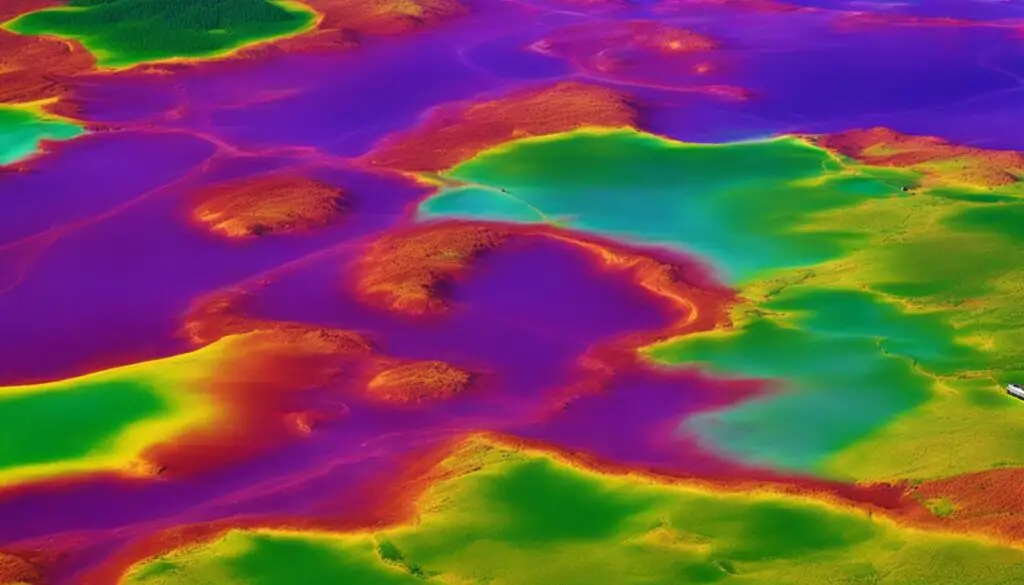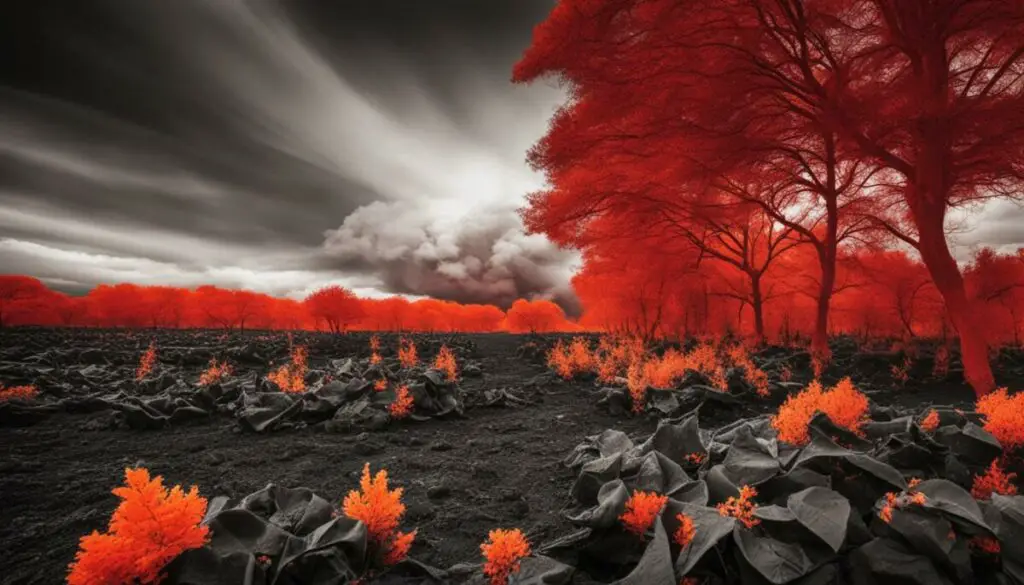Last Updated on 6 months by Francis
The greenhouse effect is a crucial process that keeps the Earth at a suitable temperature for life. Greenhouse gases, including carbon dioxide, methane, nitrous oxide, and others, absorb and re-emit infrared radiation, warming the Earth’s surface and lower atmosphere. The enhanced greenhouse effect, caused by human activities such as burning fossil fuels, increases the concentration of greenhouse gases in the atmosphere, leading to increased atmospheric heating and contributing to climate change and global warming.
Contents
Key Takeaways:
- Greenhouse gases, like carbon dioxide and methane, play a vital role in the greenhouse effect by absorbing and re-emitting infrared radiation.
- Human activities, such as burning fossil fuels, have significantly increased greenhouse gas emissions, disrupting the natural balance of the greenhouse effect.
- Increased concentrations of greenhouse gases contribute to climate change and global warming, with potential impacts including rising temperatures, extreme weather events, and sea-level rise.
- The primary greenhouse gases of concern are carbon dioxide, methane, and nitrous oxide.
- Reducing greenhouse gas emissions is crucial for mitigating the effects of climate change and preserving the Earth’s ecosystems.
The Role of Greenhouse Gases in the Greenhouse Effect

Greenhouse gases, such as carbon dioxide and methane, play a crucial role in the greenhouse effect, a natural process that keeps the Earth warm. These gases act as a “blanket” in the atmosphere, absorbing infrared radiation from the Sun and re-emitting it in all directions. This trapped heat warms the Earth’s surface and the lower atmosphere, creating a stable climate that supports life as we know it.
Carbon dioxide (CO2) is the most abundant greenhouse gas in the atmosphere, primarily due to human activities like burning fossil fuels. Methane (CH4) is also an important greenhouse gas, although it occurs in much lower concentrations. While methane is more effective at trapping heat than carbon dioxide, its concentration is significantly lower. Nitrous oxide (N2O) is another greenhouse gas with a warming potential that falls between carbon dioxide and methane.
Together, these greenhouse gases contribute to the overall greenhouse effect and act as a natural thermostat for the Earth’s climate system.
Greenhouse gases are like the Earth’s thermostat, helping to regulate global temperatures and maintain a stable climate. Without these gases, the Earth would be much colder and inhospitable to life as we know it.
The Global Warming Potential (GWP) of Greenhouse Gases
The global warming potential (GWP) is a measure of how much heat a greenhouse gas can trap in the atmosphere over a specific time period compared to carbon dioxide. Methane, for example, has a GWP 23 times greater than carbon dioxide over a 100-year period. Nitrous oxide has an even higher GWP, with a value 296 times greater than carbon dioxide.
However, it’s important to note that carbon dioxide remains the primary driver of long-term climate change due to its longer atmospheric lifespan and higher concentration.
| Greenhouse Gas | Global Warming Potential (GWP) – 100-year timescale |
|---|---|
| Carbon Dioxide (CO2) | 1 |
| Methane (CH4) | 23 |
| Nitrous Oxide (N2O) | 296 |
While methane and nitrous oxide have a greater warming potential per molecule, the cumulative effect of carbon dioxide emissions is responsible for the majority of climate change impacts we are experiencing today.
The Importance of Understanding Greenhouse Gases
Understanding the role of greenhouse gases in the greenhouse effect is crucial for comprehending the drivers of climate change. Human activities, such as the burning of fossil fuels and deforestation, have significantly increased the concentration of greenhouse gases in the atmosphere, leading to an enhanced greenhouse effect. This enhanced greenhouse effect disrupts the natural balance of the climate system, resulting in rising global temperatures and the associated impacts on our planet.
By studying the behavior, sources, and impacts of greenhouse gases, scientists and policymakers can develop strategies to mitigate and adapt to climate change. From transitioning to renewable energy sources to implementing sustainable land-use practices, addressing greenhouse gas emissions is essential for preserving a habitable planet for future generations.
The Impact of Greenhouse Gas Emissions on Climate Change
Human activities, particularly the burning of fossil fuels for energy production, have significantly increased greenhouse gas emissions in the atmosphere. Carbon dioxide levels have risen from approximately 280 parts per million (ppm) during pre-industrial times to over 400 ppm in 2018. The increased concentration of greenhouse gases, including carbon dioxide, methane, and nitrous oxide, has disrupted the natural balance of the greenhouse effect, resulting in higher global temperatures and contributing to climate change.
Greenhouse gas emissions are a major driver of climate change, impacting global temperatures and the overall stability of the Earth’s climate system. The release of carbon dioxide from burning fossil fuels is the largest contributor to greenhouse gas emissions, accounting for approximately 75% of the total. Methane and nitrous oxide, although present in lower concentrations, have a much higher warming potential than carbon dioxide.
The consequences of increased greenhouse gas emissions are far-reaching. Rising global temperatures have led to numerous environmental and ecological changes, such as the melting of polar ice caps, rising sea levels, and more frequent and severe extreme weather events. These changes have significant impacts on ecosystems, biodiversity, and human societies, including threats to food security, water availability, and public health.
| Greenhouse Gas | Anthropogenic Sources | Contribution to Global Warming Potential (GWP) |
|---|---|---|
| Carbon Dioxide (CO2) | Burning of fossil fuels, deforestation | 1 |
| Methane (CH4) | Livestock farming, rice cultivation, landfills | 25 |
| Nitrous Oxide (N2O) | Agriculture, industrial processes | 298 |
The Warming Potential of Different Greenhouse Gases

Greenhouse gases play a crucial role in the Earth’s climate system, trapping heat and contributing to the greenhouse effect. However, not all greenhouse gases are equal in their warming potential. Each gas has a different global warming potential (GWP) based on its ability to absorb and re-radiate heat. Understanding the differing GWPs of greenhouse gases helps us comprehend their relative contributions to climate change.
To illustrate the varying GWPs, let’s compare three key greenhouse gases: carbon dioxide (CO2), methane (CH4), and nitrous oxide (N2O). While carbon dioxide is the most prevalent greenhouse gas in the atmosphere, methane and nitrous oxide have significantly higher warming potentials per molecule.
| Greenhouse Gas | Global Warming Potential (GWP) |
|---|---|
| Carbon Dioxide (CO2) | 1 |
| Methane (CH4) | 23 |
| Nitrous Oxide (N2O) | 296 |
As the table demonstrates, methane has a GWP 23 times greater than carbon dioxide, while nitrous oxide has a GWP 296 times greater. However, due to its longer lifespan in the atmosphere, carbon dioxide remains the primary driver of climate change. The cumulative effect of CO2 emissions, despite its lower GWP per molecule, makes it a major contributor to global warming.
It’s important to note that addressing the emissions of all greenhouse gases is crucial in tackling climate change. While reducing carbon dioxide emissions is vital, efforts to mitigate methane and nitrous oxide emissions can have a significant impact, given their higher GWP per molecule. A comprehensive approach that addresses all greenhouse gases is essential in minimizing the warming potential and mitigating the consequences of climate change.
Human Activities and the Enhanced Greenhouse Effect

Human activities play a significant role in the exacerbation of the greenhouse effect, leading to climate change and global warming. The burning of fossil fuels, such as coal, oil, and natural gas, releases significant amounts of carbon dioxide (CO2) into the atmosphere. This accumulation of CO2 acts as a heat-trapping blanket, preventing the escape of infrared radiation from the Earth’s surface into space. As a result, the planet experiences increased atmospheric heating, causing a rise in global temperatures.
Carbon dioxide emissions from the combustion of fossil fuels account for the largest portion of greenhouse gas emissions. These emissions come from various human activities, including electricity generation, transportation, and industrial processes. In fact, the burning of fossil fuels for electricity and heat alone contributes to approximately 25% of total greenhouse gas emissions worldwide.
Other human activities, such as deforestation and agriculture, also contribute to the enhanced greenhouse effect. Deforestation reduces the Earth’s capacity to absorb carbon dioxide through the process of photosynthesis, while agriculture produces significant amounts of methane (CH4) and nitrous oxide (N2O) emissions. These greenhouse gases further enhance the warming effect by trapping heat in the atmosphere.
| Source | Percentage of Total Emissions |
|---|---|
| Electricity and Heat Production | 25% |
| Transportation | 14% |
| Agriculture | 13.5% |
| Industrial Processes | 21% |
| Deforestation | 11% |
| Other Sources | 15.5% |
It is crucial to address and mitigate these human-induced greenhouse gas emissions to stabilize the Earth’s climate and reduce the impact of the enhanced greenhouse effect. Transitioning to renewable energy sources, implementing sustainable agricultural practices, and promoting reforestation efforts are some of the steps that can help mitigate the negative effects of human activities on the climate system.
The Impacts of Rising Greenhouse Gas Concentrations
The concentration of greenhouse gases in the atmosphere has been steadily increasing due to human activities, leading to significant impacts on the Earth’s climate system. Rising greenhouse gas concentrations, particularly carbon dioxide, methane, and nitrous oxide, have contributed to an increase in global average surface temperatures. If emissions continue to rise at the current rate, it is projected that the global average surface temperature could increase by up to 4.8°C by 2100 compared to pre-industrial levels.
This rise in temperature has far-reaching consequences for our planet and its ecosystems. One of the most obvious impacts of rising greenhouse gas concentrations is the increase in the frequency and intensity of heatwaves. Heatwaves can have devastating effects on human health, agriculture, and infrastructure.
Another significant impact is the occurrence of extreme weather events such as hurricanes, droughts, and floods. These events can lead to widespread destruction and loss of life. Rising greenhouse gas concentrations also contribute to rising sea levels, threatening coastal communities and ecosystems. Additionally, changes in temperature and precipitation patterns can disrupt ecosystems, leading to habitat loss and a decline in biodiversity.
| Greenhouse Gas | Contribution to Global Warming |
|---|---|
| Carbon Dioxide (CO2) | Primary contributor due to high concentration |
| Methane (CH4) | 23 times more potent than CO2 |
| Nitrous Oxide (N2O) | 296 times more potent than CO2 |
As the concentration of greenhouse gases continues to rise, it is essential that we take immediate action to mitigate climate change. Reductions in greenhouse gas emissions, transitioning to renewable energy sources, and implementing sustainable practices are crucial steps in addressing this global challenge. By understanding the impacts of rising greenhouse gas concentrations, we can work towards a more sustainable and resilient future for our planet.
References:
- “Impacts of Climate Change.” U.S. Environmental Protection Agency, www.epa.gov/climate-impacts.
- “Climate Change Impacts.” National Geographic Society, www.nationalgeographic.org/encyclopedia/climate-change-impacts/.
- “Global Warming.” NASA Climate Kids, climatekids.nasa.gov/global-warming/.
Sources of Greenhouse Gas Emissions
In the fight against climate change, it is crucial to understand the various sources of greenhouse gas emissions. These emissions occur as a result of human activities and have a significant impact on the Earth’s atmosphere. The main sources of greenhouse gas emissions include fossil fuels, transportation, agriculture, and cement manufacture.
Fossil fuels, such as coal, oil, and natural gas, are the largest single source of global greenhouse gas emissions, contributing approximately 25% of the total. These fuels are widely used for electricity generation, heating, and transportation. The combustion of fossil fuels releases carbon dioxide (CO2) into the atmosphere, increasing its concentration and contributing to the enhanced greenhouse effect.
The transportation sector is also a significant contributor to greenhouse gas emissions, accounting for around 14% of emissions from fossil fuel combustion. This includes emissions from road vehicles, airplanes, ships, and trains. The burning of gasoline and diesel fuels releases CO2 and other greenhouse gases into the atmosphere, further contributing to climate change.
“The release of carbon dioxide from burning fossil fuels accumulates in the atmosphere, creating an enhanced greenhouse effect.”
Agriculture and land-use changes account for another 25% of net anthropogenic greenhouse gas emissions. This includes emissions from livestock production, deforestation, and the conversion of land for agricultural purposes. Livestock, particularly cows and sheep, produce methane (CH4) during digestion, which is a potent greenhouse gas. Additionally, deforestation releases stored carbon into the atmosphere, further contributing to climate change.
Cement manufacture is another notable source of greenhouse gas emissions. The production of cement involves the heating of limestone, resulting in the release of CO2 as a byproduct. This process accounts for a significant portion of industrial emissions and contributes to the overall concentration of greenhouse gases in the atmosphere.
| Source of Greenhouse Gas Emissions | Percentage Contribution |
|---|---|
| Fossil Fuels | 25% |
| Transportation | 14% |
| Agriculture and Land-Use Changes | 25% |
| Cement Manufacture | Varies |
Other Factors Affecting Greenhouse Gas Concentrations
While greenhouse gases play a significant role in the greenhouse effect, there are other factors that can influence their concentration and behavior in the atmosphere.
Aerosols, for example, are tiny particles suspended in the air. They can have both cooling and warming effects on the climate. Certain human activities, such as vehicle and factory emissions, produce aerosols that reflect sunlight and result in atmospheric cooling. This interplay between aerosols and greenhouse gases adds complexity to our understanding of the climate system.
Ozone, although present in smaller quantities, is also a greenhouse gas. It contributes to the greenhouse effect, just like carbon dioxide and methane. While ozone depletion is a concern in the stratosphere, its presence in lower atmospheric levels can contribute to the warming of the Earth’s surface.
Understanding the interactions between aerosols, ozone, and greenhouse gases is crucial for comprehending the complexities of climate change and accurately predicting its impacts. Scientists continue to study these relationships to improve climate models and inform effective strategies for mitigating the effects of global warming.
FAQ
Do greenhouse gases absorb infrared radiation?
Yes, greenhouse gases including carbon dioxide, methane, and nitrous oxide, absorb and re-emit infrared radiation, contributing to the greenhouse effect.
What is the greenhouse effect?
The greenhouse effect is a natural process that keeps the Earth at a suitable temperature for life by trapping heat from the Sun in the atmosphere.
How do greenhouse gases impact global temperatures?
Greenhouse gases act like a “blanket” in the atmosphere, trapping heat and warming the Earth’s surface and lower atmosphere, leading to higher global average temperatures.
What is the role of carbon dioxide, methane, and nitrous oxide in the greenhouse effect?
Carbon dioxide, methane, and nitrous oxide are the primary greenhouse gases contributing to the greenhouse effect and climate change.
What are the main sources of greenhouse gas emissions?
The main sources of greenhouse gas emissions are burning fossil fuels for energy, transportation, agriculture, deforestation, and industrial processes.
How do human activities enhance the greenhouse effect?
Human activities, particularly the burning of fossil fuels, release greenhouse gases into the atmosphere, leading to increased concentrations and an enhanced greenhouse effect.
How do rising greenhouse gas concentrations impact the Earth?
Rising greenhouse gas concentrations contribute to climate change, resulting in higher global temperatures, more frequent extreme weather events, rising sea levels, and disruptions to ecosystems and biodiversity.
What is the global warming potential of different greenhouse gases?
Each greenhouse gas has a different global warming potential, with methane having a higher potential than carbon dioxide, but carbon dioxide remaining the most abundant greenhouse gas due to its longer atmospheric lifespan.
What other factors affect greenhouse gas concentrations?
Aerosols and ozone also affect greenhouse gas concentrations and the greenhouse effect, with aerosols having both cooling and warming effects on the Earth’s climate system.









